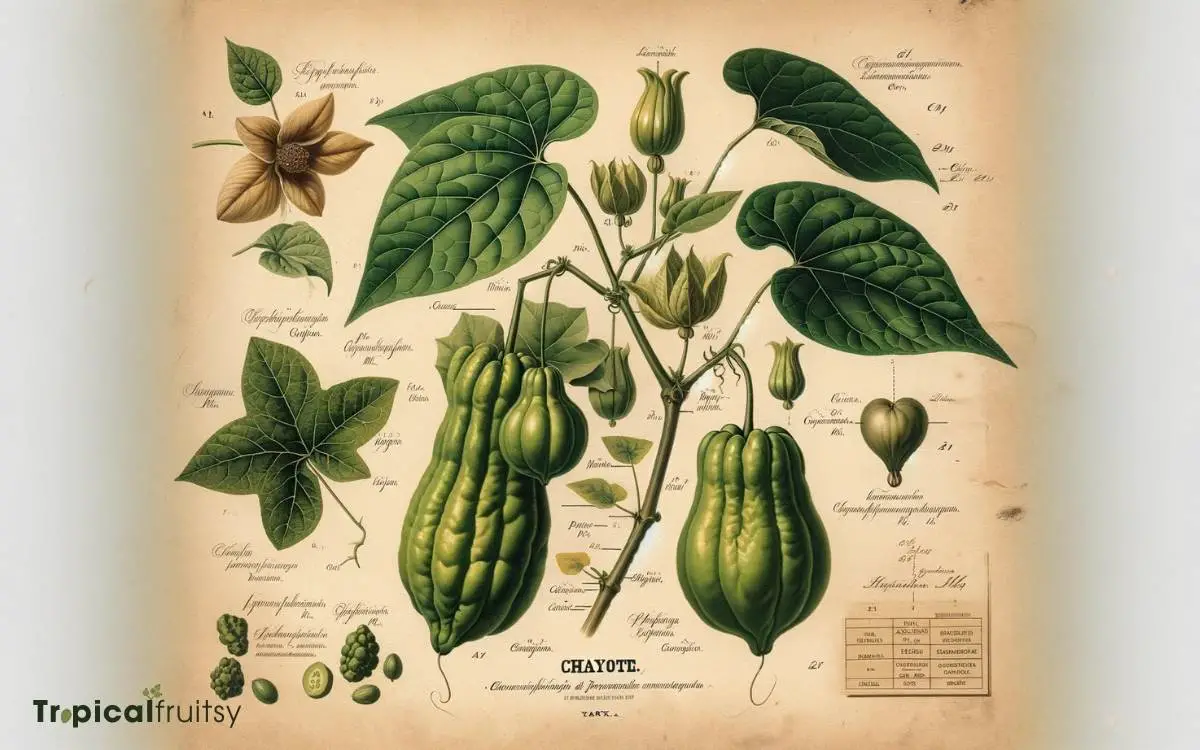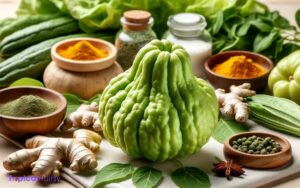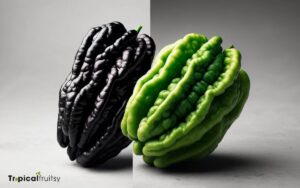What Is the Classification of Chayote? Explained!
Chayote, known by its scientific name Sechium edule, is classified within the gourd family Cucurbitaceae. This family encompasses a diverse group of plants including cucumbers, melons, and squashes.
As a flowering plant, chayote is part of the Division Magnoliophyta and Class Magnoliopsida, indicating its status as a dicot. It falls under the Order Cucurbitales, which is characterized by climbing and trailing vines.
The genus Sechium is where chayote specifically resides, with the species name edule.
The classification of chayote follows the standard hierarchy of biological taxonomy:
This systematic approach to classification aids in the study and understanding of chayote’s growth habits, nutritional content, and its place in the ecosystem.
Delve into the world of chayote, a versatile gourd that’s part of the diverse Cucurbitaceae plant family.

Key Takeaway
Chayote Classification in the Plant Kingdom
| Taxonomic Rank | Classification |
|---|---|
| Kingdom | Plantae |
| Division | Magnoliophyta |
| Class | Magnoliopsida |
| Order | Cucurbitales |
| Family | Cucurbitaceae |
| Genus | Sechium |
| Species | edule |
Kingdom: Plantae Essentials
Chayote, scientifically known as Sechium edule, falls under the Kingdom Plantae, which encompasses all multicellular, photosynthetic organisms commonly referred to as plants.
This Kingdom is characterized by the presence of cellulose in the cellular walls, chlorophyll and other pigments for capturing light energy, and the ability to perform photosynthesis, a metabolic process converting light energy into chemical energy.
As a member of this taxonomic category, Chayote exhibits these foundational attributes, demonstrating its autotrophic capability to synthesize organic compounds from inorganic sources.
Additionally, it follows an alternation of generations lifecycle typical for plants, involving a multicellular diploid sporophyte stage and a multicellular haploid gametophyte stage.
The classification within Plantae is critical for understanding the evolutionary adaptations and ecological relationships of Chayote.
Division: Magnoliophyta Insights
Belonging to the division Magnoliophyta, the Chayote plant is classified among angiosperms, which are characterized by the presence of flowers and enclosed seeds.
This division, also known as flowering plants, constitutes the most diverse group within the plant kingdom, exhibiting a myriad of reproductive and morphological adaptations that have enabled them to dominate most terrestrial ecosystems.
Sechium edule, the scientific name for Chayote, exhibits the definitive features of this division, such as a well-developed vascular system for nutrient transport and a complex life cycle involving alternation of generations.
The organism’s reproductive structures are organized into a system that enhances pollination efficiency, with the ovules encased within an ovary, which upon fertilization, develops into a fruit – a key characteristic distinguishing Magnoliophyta from other plant divisions.
Class: Magnoliopsida Breakdown
The Chayote plant, Sechium edule, falls under the class Magnoliopsida, which encompasses dicotyledonous plants characterized by two embryonic leaves or cotyledons in their seedlings.
This class, within the angiosperms, exhibits considerable diversity in morphological and anatomical attributes.
Members of Magnoliopsida typically possess a branching vein structure within their leaves and a vascular system arranged in concentric circles within the stem, allowing for efficient transport of nutrients and water.
Furthermore, the floral structure generally displays a tetramerous or pentamerous organization, reflecting the evolutionary complexity within this class.
The chayote, as a member of this class, shares these fundamental characteristics, aligning it with other dicots in both ecological function and genetic lineage.
Understanding these traits provides insights into its botanical categorization and evolutionary adaptations.
Order: Cucurbitales Overview
The order Cucurbitales is characterized by a diverse range of dicotyledonous plants, which are predominantly herbaceous, and exhibit a unique tendril-bearing feature.
This order encapsulates a variety of species, including the chayote (Sechium edule), that are significant both ecologically and economically, given their roles as food crops and ornamental plants.
An analysis of the order’s phylogenetic relationships reveals insights into the evolutionary adaptations that have facilitated the success of these species across various biomes.
Order Characteristics
Within the plant kingdom, the order Cucurbitales is renowned for comprising a variety of flowering plants, including the chayote, that are often characterized by their fleshy fruits, such as melons, cucumbers, and gourds.
These plants display a range of features that are distinct to the order:
- Unisexual flowers: Plants within Cucurbitales typically exhibit unisexual flowers, meaning they produce separate male and female flowers, a condition known as monoecy.
- Tendrils: A common morphological trait is the presence of tendrils, which are specialized structures that facilitate climbing or support by coiling around objects.
- Pepo: The fruit type associated with many species in this order is classified as a pepo, a berry with a hard rind, developed from an inferior ovary.
These characteristics underpin the adaptive strategies and evolutionary success of Cucurbitales species in diverse ecological niches.
Related Species
While the chayote (Sechium edule) is a member of the Cucurbitaceae family, it shares its order Cucurbitales with other economically significant plants such as squash, pumpkins, and cucumbers.
These species display a diverse array of morphological characteristics and utilize similar reproductive strategies. Their shared phylogenetic lineage suggests a common ancestry, which has diverged to adapt to various ecological niches.
| Family | Genus | Common Name(s) |
|---|---|---|
| Cucurbitaceae | Cucurbita | Squash, Pumpkins |
| Cucurbitaceae | Cucumis | Cucumbers, Melons |
| Cucurbitaceae | Citrullus | Watermelons |
| Cucurbitaceae | Lagenaria | Bottle Gourds |
| Cucurbitaceae | Momordica | Bitter Melon, Gourds |
Family: Cucurbitaceae Connections
The Chayote (Sechium edule) belongs to the family Cucurbitaceae, which encompasses a wide array of gourd-bearing species with significant agricultural value.
Through phylogenetic analysis, chayote shares a close taxonomic relationship with melons (Cucumis spp.) and cucumbers (Cucumis sativus), united by shared morphological traits and genetic sequences.
This kinship extends to various squash varieties, confirming a botanical affinity that underscores the family’s contribution to global food diversity and horticultural practices.
Relatives: Melons, Cucumbers
Chayote is a member of the Cucurbitaceae family, which encompasses over 900 species including melons and cucumbers.
This extensive family is characterized by its flowering plants, most of which are vines, and is colloquially known as the gourd or squash family.
- Cucumis melo (melon): Includes diverse forms such as cantaloupes and honeydews, exhibiting a wide range of size, shape, and flavor profiles.
- Cucumis sativus (cucumber): Known for its crisp texture and refreshing taste, it is a staple in culinary applications across various cultures.
- Citrullus lanatus (watermelon): Valued for its hydrating and sweet properties, this fruit is a quintessential summer staple.
Each of these relatives shares common botanical features and genetic linkages with chayote.
Chayote: Squash Variety
Within the diverse Cucurbitaceae family, chayote (Sechium edule) stands out as a distinctive squash variety, with unique characteristics that differentiate it from its melon and cucumber relatives.
As a perennial climber, chayote exhibits a prolific growth habit characterized by tendrils and a robust stem structure supporting its vegetative mass.
Botanically, it is classified as a monoecious plant, bearing both male and female flowers on the same specimen, a trait that enhances its reproductive efficiency.
The fruit itself is botanically a pepo, a type of berry with a hard outer rind inherent to members of the squash family. Its fleshy mesocarp is consumed as a vegetable, offering a subtle flavor and crisp texture, which has led to its culinary versatility and global dissemination.
Genus: Sechium Explained
Belonging to the Cucurbitaceae family, the genus Sechium comprises various gourd species, including the well-known chayote (Sechium edule).
This genus is characterized by its perennial climbing plants that produce tendrils, facilitating their growth on supporting structures.
The fruit of these species, botanically classified as a pepo, exhibits a wide range of morphological diversity, often influenced by environmental factors and genetic variation.
- Monotypic Nature: Sechium is often described as monotypic, with Sechium edule being the primary species of economic importance and focus of horticultural practices.
- Morphological Characteristics: Members of Sechium exhibit fibrous roots, palmately lobed leaves, unisexual flowers, and fleshy fruits with a single large seed.
- Cultivation and Usage: Sechium species, particularly S. edule, are cultivated for their edible fruit, shoots, and tuberous roots, contributing to their significance in agricultural systems.
The analysis of Sechium reveals a genus with a singular prominence in both botanical classification and practical agriculture.
Species: Sechium Edule Profile
One of the most notable members of the genus Sechium is Sechium edule, commonly referred to as chayote, which holds significant agricultural and culinary value.
This perennial climber is part of the Cucurbitaceae family, and it is known for its edible fruit which exhibits considerable morphological diversity.
The species is dioecious, with separate male and female plants, and is predominantly propagated vegetatively. Sechium edule thrives in a variety of climates and is characterized by its high nutritional content, including vitamins, minerals, and fiber.
| Characteristic | Detail |
|---|---|
| Family | Cucurbitaceae |
| Habit | Perennial Climber |
| Propagation | Vegetative |
| Sexual System | Dioecious |
| Economic Importance | Edible Fruit, Medicinal |
Conclusion
The chayote (Sechium edule) is a species distinctly classified within the kingdom Plantae, division Magnoliophyta, class Magnoliopsida, order Cucurbitales, and family Cucurbitaceae, with its genus being Sechium.
This meticulous taxonomic categorization reflects its evolutionary lineage and ecological role.
How might such classification inform our understanding of its cultivation and usage? The chayote’s botanical classification not only aids in scientific communication but also underscores its agricultural and nutritional significance.






